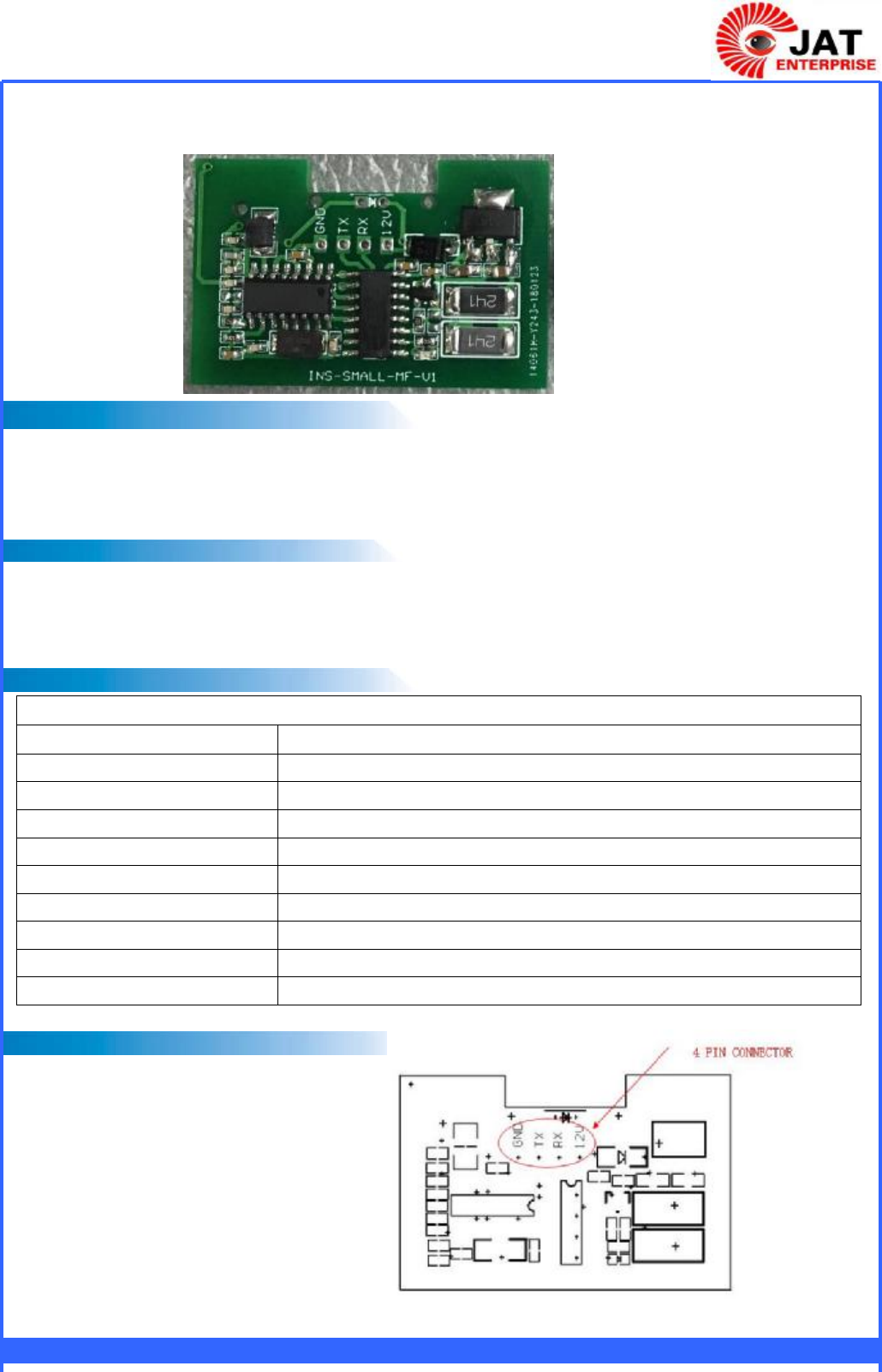INS Global HF20 13.56M RFID Reader module User Manual HF20 IM V1
INS Global INC 13.56M RFID Reader module HF20 IM V1
User namual

Model: HF20
Introduction
HF20 is small size, 13.56M RFID card reader module, with TTL interface, It programmed with
client mifare card secure code and read certain data from the card, once card is read successful,
the data is sent to host via TTL interface.
Host may enable or disable the on board white LED communication via TTL.
Feature
TTL interface; Read pre-programmed mifare card data.
12V DC working voltage
Specification
Support client programmed miafre card
Size 41*26mm
Power input 12V DC @ 100mA
Interface TTL, 9600, N,8,1
Reading distance 2-4 cm
Frequency 13.56M
Operation temperature -30 C to +60 C
operation humidity 5%-95% relative humidity non-condensing
Audio/Visual Indication LED
Weight 12
card number output format TTL, ASCII
Wiring and Function
Connect module to host by 4 PINs connector
Once card is detected well, RED LED will
Flash one time and data is sent via Tx to host
Turn on White LED:
Host send “ON” in ASCII to module
Turn off White LED
Host send “OFF” in ASCII to module
13.56M RFID Reader module

This device complies with Part 15 of the FCC rules. Operation is subject to the
following two conditions: 1) this device may not cause harmful interference, and 2)
this device must accept any interference received, including interference that may
cause undesired operation.
Note: This equipment has been tested and found to comply with the limits for a Class
B digital device, pursuant to part 15 of the FCC Rules. These limits are designed to
provide reasonable protection against harmful interference in a residential installation.
This equipment generates uses and can radiate radio frequency energy and, if not
installed and used in accordance with the instructions, may cause harmful
interference to radio communications. However, there is no guarantee that
interference will not occur in particular installation. If this equipment does cause
harmful interference to radio or television reception, which can be determined by
turning the equipment off and on, the user is encouraged to try to correct the
interference by one or more of the following measures:
--Reorient or relocate the receiving antenna.
--Increase the separation between the equipment and receiver.
--Connect the equipment into an outlet on a circuit different from that to which the
receiver is connected.
--Consult the dealer or an experienced radio/TV technician for help.
Changes or modifications not expressly approved by the party responsible for
compliance could void the user’s authority to operate the equipment.
FCC Radiation Exposure Statement
This modular complies with FCC RF radiation exposure limits set forth for an
uncontrolled environment. This transmitter must not be co-located or operating in
conjunction with any other antenna or transmitter.
Attention: Limited Modular Approval - this RF Module may not be sold to the generic public and
requires professional installation. Due to the fact that this RF Module is not equipped with an
own shielding, the end-product incl. this RF Module has to show compliance to the FCC rules
(15C / radiated emissions).
(OEM) Integrator has to assure compliance of the entire end-product incl. the integrated RF
Module. Additional measurements (15C) and/or equipment authorizations
(e.g either a complete new certification or a Class II Permissive Change) may need to be
addressed depending on co-location or simultaneous transmission issues if applicable.
Integrator is reminded to assure that these installation instructions will not be made available to
the end-user of the final host device.
The Integrator will be responsible to satisfy SAR/ RF Exposure requirements, when the module
integrated into any (portable, mobile, fixed) host device.
The final host device, into which this RF Module is integrated" has to be labeled with an auxiliary
label stating the FCC ID of the RF Module, such as "Contains FCC ID: 2AR9A-HF20".